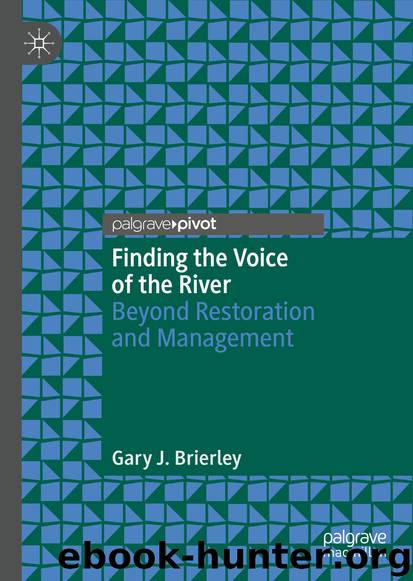Finding the Voice of the River by Gary J. Brierley

Author:Gary J. Brierley
Language: eng
Format: epub
ISBN: 9783030270681
Publisher: Springer International Publishing
Box 3.6 Enhancing the Self-Healing Capacity of River Systems by Working with Recovery and Applying Space to Move Programmes
Working with recovery presents an important basis to enhance river health (Fryirs et al. 2018). Sometimes improvements reflect unintentional responses to particular circumstances. The Millennium Drought had a devastating impact on socio-economic conditions in southeastern Australia. However, as pressures on the land were decreased and stocking rates were reduced, vegetation was able to recover from available seed stocks along the riparian corridor. This increased the diversity of instream habitat . Also, when the next significant floods occurred in this region, the rivers had become more resilient to change. Relative to pre-drought floods of equivalent magnitude, enhanced instream roughness delayed conveyance of flood peaks, reducing the extent of erosion and decreasing downstream impacts. Such good news stories communicate benefits of leaving a river alone, allowing the inherent capacity for self-healing to support recovery mechanisms. However, commitment to ongoing maintenance is required, as weed invasions threaten various ecosystem values of these riparian corridors.
Space to move, freedom space and erodible corridor initiatives are examples of programmes that ‘re-wild’ or ‘re-nature’ rivers by allowing channels to adjust—to express their voice (e.g. Habersack and Piégay 2007; Kondolf 2011, 2012; Piégay et al. 2005). Such accommodations with nature leave the river alone as far as practicable. Alluvial rivers are quite able to look after themselves, creating their own resistance elements, working out how many channels they want, what size they want them to be and their sinuosity (and hence their slope). Flows selectively rework bed materials and interact with floodplains, forming patterns of features which consume flow energy in the most efficient way. This creates and regenerates the dynamic physical habitat mosaic of a river, supporting conservation and biodiversity programmes .
In addition, space to move interventions now form an important component of catchment-scale approaches to ‘living with floods’. Such programmes reduce flow rates by trapping water for longer periods of time closer to source. More gradual flow releases reduce the erosive potential of flood flows. Recent applications in Europe have reconstructed wetlands and restored floodplains to hold back floodwater, releasing it more slowly. Some space to move interventions manipulate instream habitat , others increase the width of the active channel zone, while more interventionist practices reconnect former channels and oxbows. Benefit-cost analyses demonstrate the effectiveness of these interventions, negating maintenance costs for infrastructure that keep the channel in place while providing additional buffering capacity in efforts to cope with uncertain futures (Buffin-Bélanger et al. 2015). Additional socio-economic and cultural benefits of such programmes include enhanced spiritual/emotional connections of dynamic, healthier rivers and recreational and amenity value associated with the use of buffer strips.
Embracing the role of beavers as ecosystem engineers presents an intriguing extension to such initiatives. Beaver dams literally rebuild habitats and reconstruct biophysical environments along watercourses in many parts of North America and Europe, disconnecting flow, sediment and nutrient transfer. Standing back and allowing this to happen—leaving it to beaver —presents a cheap and cheerful approach
Download
This site does not store any files on its server. We only index and link to content provided by other sites. Please contact the content providers to delete copyright contents if any and email us, we'll remove relevant links or contents immediately.
Man-made Catastrophes and Risk Information Concealment by Dmitry Chernov & Didier Sornette(5921)
The Revenge of Geography: What the Map Tells Us About Coming Conflicts and the Battle Against Fate by Kaplan Robert D(4034)
Zero Waste Home by Bea Johnson(3776)
COSMOS by Carl Sagan(3553)
Good by S. Walden(3485)
In a Sunburned Country by Bill Bryson(3481)
The Fate of Rome: Climate, Disease, and the End of an Empire (The Princeton History of the Ancient World) by Kyle Harper(3003)
A Wilder Time by William E. Glassley(2817)
Camino Island by John Grisham(2762)
The Ogre by Doug Scott(2630)
Organic Mushroom Farming and Mycoremediation by Tradd Cotter(2626)
Human Dynamics Research in Smart and Connected Communities by Shih-Lung Shaw & Daniel Sui(2464)
Energy Myths and Realities by Vaclav Smil(2436)
The Traveler's Gift by Andy Andrews(2408)
9781803241661-PYTHON FOR ARCGIS PRO by Unknown(2321)
Inside the Middle East by Avi Melamed(2305)
Birds of New Guinea by Pratt Thane K.; Beehler Bruce M.; Anderton John C(2222)
A History of Warfare by John Keegan(2183)
Ultimate Navigation Manual by Lyle Brotherton(2129)
